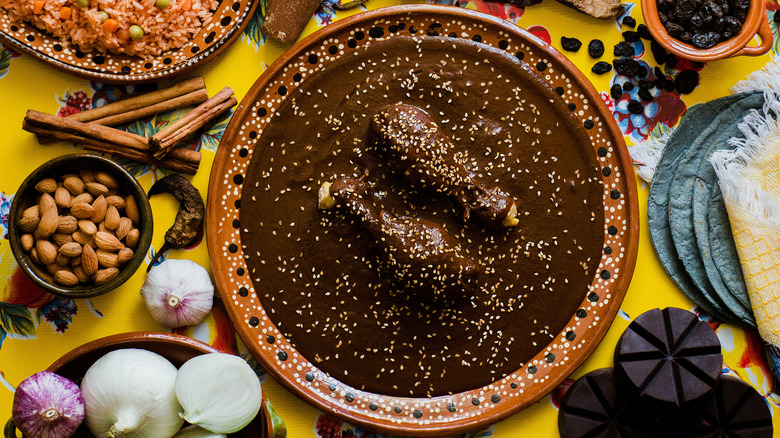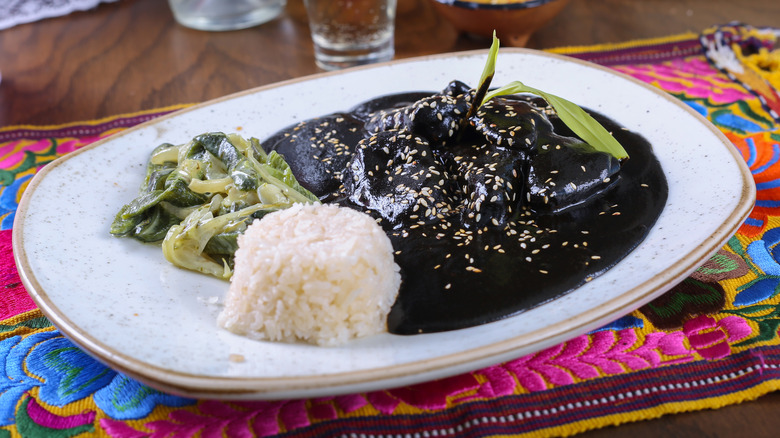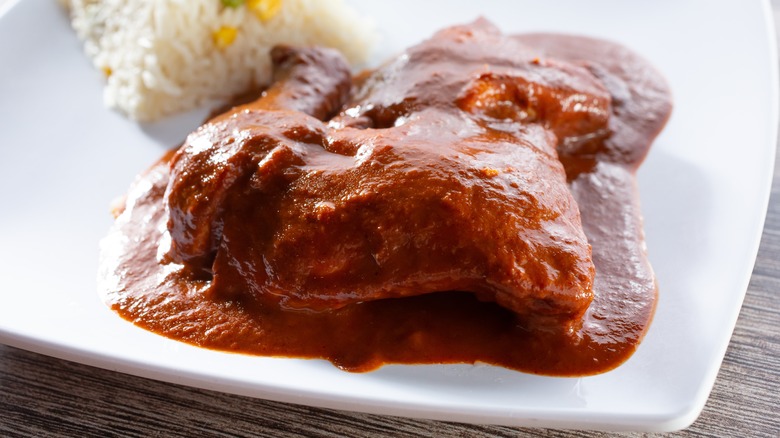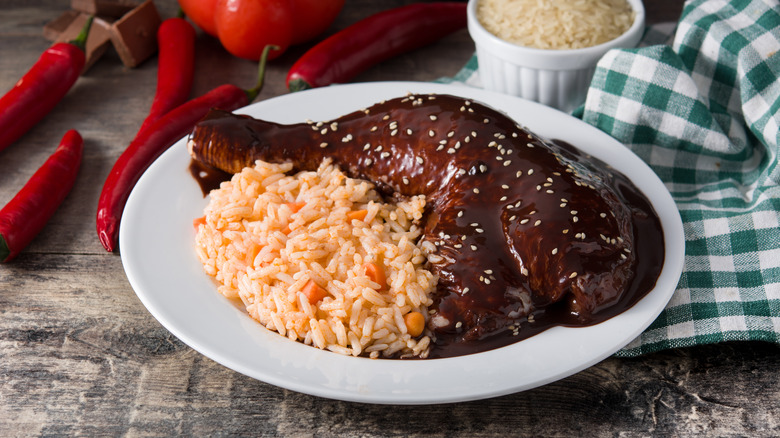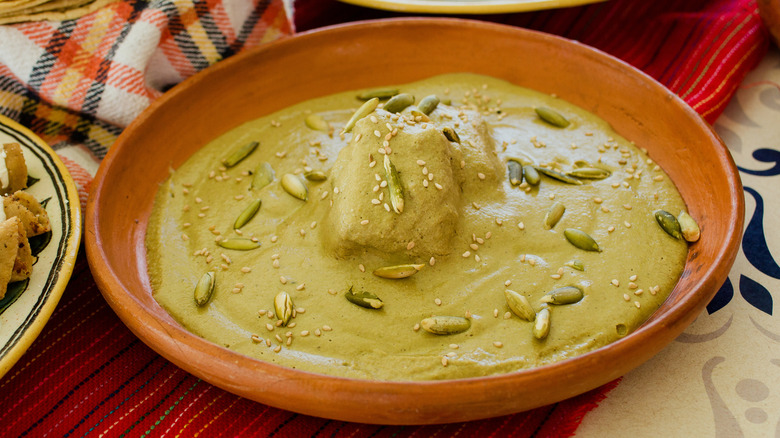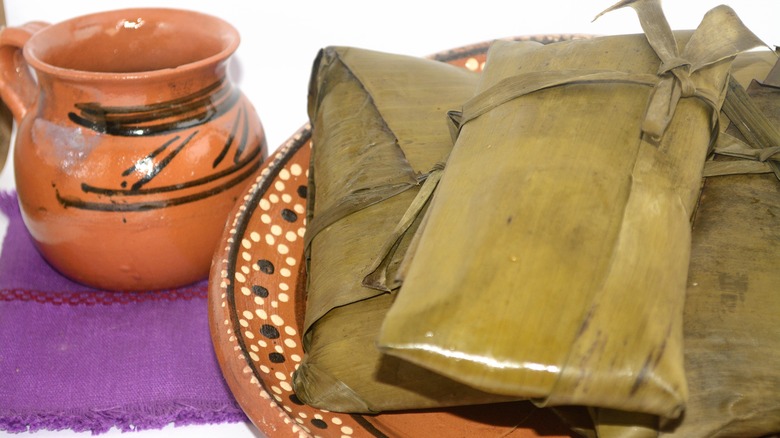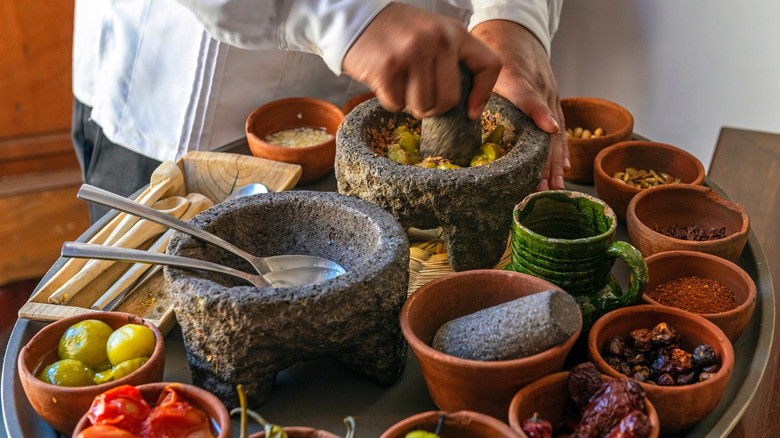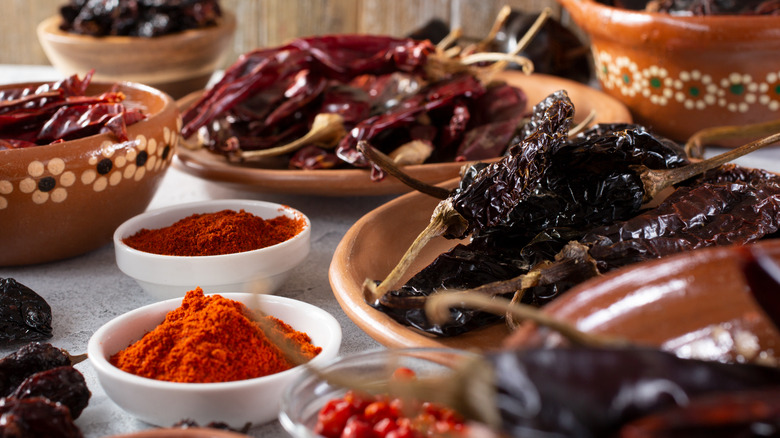The 7 Moles Of Oaxaca
Anyone who dismisses Mexican food as limited to simple treats such as nachos and queso will change their mind after tasting real Mexican mole. Pronounced "moe – lay" and derived from the classical Nahuatl word for "sauce," it's known to connoisseurs of Mexican cooking as one of the crowning achievements of the Mexican kitchen. It's also one of the oldest known preparations in Mexico, with roots pre-dating European contact: A 16th-century ethnography of Mesoamerican groups describes versions of mole being made by Aztec cooks to honor the Aztec god of fire.
But if you think an ancient dish devised by people without food processors, stoves, or other modern conveniences would be simple and rustic, think again. The best Mexican moles rival the classic French sauces in their subtlety and complexity. They typically contain a careful balance of 20 or more ingredients, which can include chiles, chocolate, spices such as cinnamon, pumpkin seeds, and more. Each traditional mole type requires its own, non-negotiable combination of chiles and flavorings (chile types are not interchangeable in Mexican cooking). Today, the state of Oaxaca in southwestern Mexico, which boasts a large population of indigenous groups who proudly maintain many of their ancient traditions, is known as Mexico's epicenter for mole-making. Oaxacans will tell you they make seven traditional mole types — here's what they are and how to enjoy them.
Mole negro
If you've had mole in a stateside Mexican restaurant, chances are it was mole negro, the best-known of Oaxaca's seven moles and a signature dish of the region. Its name translates as "black mole," and the sauce is indeed intensely dark and thick. Its intense color — and intriguingly rich sweet-spicy flavor – come from a unique combination of dark chocolate and four types of chiles (chilhuacle negro, chilhuacle rojo, chile pasilla oaxaqueño, and chile mulato). Its other ingredients include onions, garlic, tomatoes, peanuts, almonds, raisins, sesame seeds, and spices, along with a bit of bread for thickening.
Mole negro may be a common celebration dish in Oaxaca, but making it requires a serious commitment of time and elbow grease. All the ingredients must be prepped, toasted, and blended together in a strict sequence, then simmered together for several hours to ensure the flavors are properly blended and balanced. For this reason, most recipes for mole negro make enough to feed a crowd — there's hardly any point in spending a whole day in the kitchen just to make just a small batch of the stuff. In Oaxaca, mole negro is often served with turkey (the broth created from simmering the turkey is typically used in the sauce). But you can also find it as a sauce for an enchilada variant known as enmoladas, as well as a flavoring for tamale fillings.
Mole colorado
A number of Oaxaca's moles are simply named for their color, and mole colorado (colored, or red, mole) is one of these. Expect it to be more of a brick-red sauce than like a more recognizable Italian red sauce. Like mole negro, it's a thick, rich sauce with a hint of sweetness (it also contains chocolate and raisins and is thickened with ground, toasted nuts), but with less-dominant flavors than those of mole negro. The chiles used in mole colorado — pasillas, anchos, and chiles de arbol –- contribute to its reddish hue and brighter flavor profile.
A variant of mole colorado is mole coloradito, which translates roughly as "little red mole." This variant gets its name from its less intensely red color, which is more of a reddish brown than distinctly red, due to the larger proportion of green herbs in the sauce. However, some recipes for mole coloradito contain few, if any, green herbs at all, and some sources cite mole coloradito, rather than mole colorado, as one of Oaxaca's classic seven variants. So are they in fact different, and if so, what distinguishes them? The only way to find out is to taste them for yourself.
Mole poblano
Oaxaca may be Mexico's powerhouse state for mole making, but the neighboring state of Puebla is not far behind. Some sources argue that while today Oaxaca is known for its many varieties of mole, mole itself was originally invented in Puebla. One variety developed in Puebla — mole poblano — is so popular it's named after the state itself (poblano basically means "from Puebla") and has been embraced by Oaxacan cooks as one of their specialties as well.
Mole poblano features ancho, guajillo, and mulatto chiles, and is a dark reddish brown in color. Like some other mole types, it gets its sweetness from chocolate and fruits such as raisins (and in some cases, plantains). Vegetables that can include onions, tomatillos, and /or tomatoes contribute brightness, and spices including allspice, coriander, and aniseed add depth and complexity. It's the sweetest and spiciest of the common moles because of both the fruit and the large proportion of chiles in the recipe. Like mole negro, it's typically served with poultry such as chicken or turkey, along with plenty of rice to sop up all the flavorful sauce.
Mole verde
Mole verde, or green mole, is by far the lightest and brightest of Oaxaca's seven moles. It gets its heat (there's usually not much) from fresh, rather than dried chiles — in this case, fresh jalapeños. And most of its bulk and flavor comes from a garden's worth of fresh vegetables, which can include tomatillos, cactus pads (nopales), roasted poblano peppers, and herbs including cilantro, parsley, epazote, and hierba santa (the latter two being common Oaxacan herbs that can be found dried in some Latin specialty markets). Some variants add lettuce or green beans to the mix as well. The mole is generally thickened with ground, green pumpkin seeds.
If you're thinking of making your own mole from scratch, mole verde may be a good place to start. Because it contains mostly fresh, rather than dried, ingredients, you won't have to spend as much time rehydrating and prepping the ingredients. And apart from a few special Oaxacan herbs (which some recipes omit), most of the ingredients are easily available in American supermarkets. While mole verde, like many other mole varieties, is typically made with a base of chicken broth and served with chicken, it can also be made with vegetable broth and served with veggies and tofu for a festive meatless meal.
Mole amarillo
Mole amarillo, or yellow mole, is another of the lighter and brighter mole variants served in Oaxaca. It's typically identified with the coastal regions, central valleys, and isthmus of Oaxaca, and gets its signature yellow color from its distinctive mix of chilhuacle amarillo, chilcosle, costeño amarillo, and guajillo chiles. It also contains onions, garlic, tomatoes, tomatillos, warm spices such as cinnamon and cloves, as well as fresh herbs, and is thickened with masa (the nixtamalized corn meal used to make corn tortillas and tamales).
Mole amarillo is distinct not just because of its color, but because of where and how it's eaten. Unlike most other moles, which are primarily restaurant or special-occasion food, mole amarillo is commonly served by street vendors in portable treats such as tacos and empanadas. These empanadas will typically contain shredded chicken enrobed in yellow mole. As a sit-down meal, mole amarillo is often served as a stew featuring chicken, cooked vegetables such as chayote, green beans, and potatoes, and tiny round masa dumplings called chocoyotes.
Mole manchamantel
Manchamantel translates as "tablecloth staining," which speaks to not just its deep reddish-brown color, but a spicy-sweet taste so tantalizing you won't care if you make a mess while eating it. Mole manchamantel gets its heat — and deep red color — from ancho chiles, and its sweetness from fresh pineapple and plantains. (In some versions, chorizo also contributes heat and staining potential.) While some versions incorporate the sweet fruit into the mole itself, others serve the fruit lightly grilled with the sauce along with the cooked meat. Mole manchamantel also contains tomatoes, onions, and garlic, along with cinnamon, oregano, bay leaves, and nutmeg, and is thickened with ground almonds or peanuts. A bit of vinegar added towards the end contributes brightness. Its richness and sweetness make it a good partner for pork as well as chicken.
Mole manchamantel is one of the less-common moles of Oaxaca, so it is a bit harder to find at restaurants there than the more popular mole types. But if you're a fan of sweet-hot barbecue sauces, you should seek it out should you find yourself in Oaxaca — or roll up your (machine-washable) sleeves and make it yourself.
Mole chichilo
Mole chichilo is by far the rarest and least known of Oaxaca's moles, at least outside of Oaxaca. It's also nearly impossible to find in restaurants, even those that specialize in the labor-intensive work of making the region's moles. There are two reasons for this: For one, the chilhuacle negro chiles that contribute to the mole's nearly black color and distinctive flavor are hard to come by. The second, and more important reason, is that by tradition, mole chichilo is made only for funerals.
Given its role as a food for mourning, it seems appropriate that mole chichilo is the darkest and least sweet of Oaxaca's seven moles. In mole chichilo, the chiles are deeply charred before being ground, which contributes a distinctive flavor as well as the mole's dark color. Avocado leaves contribute a distinct anise-like aroma and aftertaste. And unlike most other moles, it's made with beef broth, rather than turkey or chicken broth.
While it has a more austere and subdued flavor profile than Oaxaca's other moles, it's no less labor-intensive to make. So by tradition, women gather in the home of the deceased to help the family make mole chichilo, as Oaxacan restaurateur Evangelina Aquino Luis told Business Insider. This suggests that the practice of making mole chichilo is as much a part of the grieving and healing process as eating it. "It's a mole of brotherhood, solidarity, and comradeship," Aquino Luis said through a translator to Business Insider.

